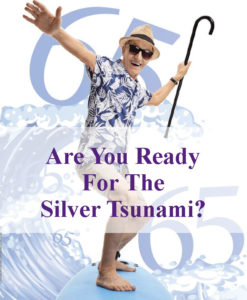I take pride in being a baby boomer, one of those born between 1945 and 1964, the second-largest generation (after millennials) in U.S. history. As of 2011, the first of the 78 million baby boomers turned 65. For the next 19 years, nearly 10,000 people a day will turn 65—and that doesn’t include the demographic that reached 65 before 2011.

Retailers are calling this huge wave of baby boomers the “silver tsunami.” Businesses such as McDonald’s and CVS drug stores are widening their aisles and entrances and lowering their shelves to make it easier for seniors to shop. Boomers expect excellence in services and quality of life.
Who are Today’s Seniors?
According to the American Association of Retired Persons (AARP) magazine, seniors are the fastest-growing population to embrace technology, spending $7 billion annually online, and their income per capita is 26 percent higher than the national average. Some other facts about today’s seniors:
- They control 70 percent of all wealth in the U.S., have more than $2 trillion in annual income—and have more disposable income than any other age group.
- 84 percent say they “would be lost” without their computers and the internet.
- They exercise—16 million say they exercise at least three times a week and 35 percent report moderate physical activity 12 times per month; though 52 percent report no physical activity.
- They buy 51 percent of all over-the-counter drugs and 74 percent of all prescription drugs.
- They account for 60 percent of all health care spending.
- 49 percent cite health and wellness as their primary concern.
- 72 percent have one or more chronic diseases.
- 43 percent have high blood pressure and 16 percent have diabetes.
Also, according to the American Academy of Orthopaedic Surgeons, there is a 673 percent predicted increase in knee replacements among boomers by 2030, and an expected 174 percent increase in hip replacements.
These statistics suggest that there is a huge demographic interested in—and with sufficient income to afford—integrative health and wellness offerings such as massage and spa services.
Spa Services and Caregiving
After 10 years in the massage and spa field, I made a life change to provide home care to my father who had Alzheimer’s disease, then provided care for my mother, who had terminal cancer. By modifying chair massage techniques, I was able to provide massage for my parents in their armchairs, wheelchairs and hospital beds.
My dad loved to lean back in his lounger while I did basic skin care on his face. My mom had a paraffin bath for her arthritis, and I had moist heat packs and a collection of essential oils, so it was easy to turn their home into a day spa.
In 2004 I connected with a continuing care retirement community that was looking for a geriatric massage therapist to work with their residents in all levels of care. They offered me a contract position with a treatment room in their wellness clinic for the residents who were in independent living.
I also provided in-room massage and spa services for residents in the assisted living, skilled nursing and memory care units. What follows here are some suggestions for massage and spa approaches to seniors in your practice.
Positioning for Seniors’ Needs
Proper positioning for seniors is just as critical for them as proper body mechanics are for the therapist. Eighty percent of my clients cannot lie prone on a massage table—and those who can struggle to turn over and be supine. The side-lying position I learned for pregnancy is ideal: Provide cervical support first, position a pillow between the knees and ankles, and give them a “huggy pillow” at their chest for comfort and support for their arms.
When I work with folks in hospital beds, since their beds are adjustable I raise the bed’s height to improve my body mechanics. (It becomes a hydraulic table!) Also, when the client is supine in a hospital bed you can raise the bed, remove the footboard and give foot reflexology.
Moist Heat Application
Seniors love moist heat, so when I do in-room spa services I carry a microwavable neck-and-shoulder wrap in a wheeled case, with extra pillowcases to keep it sanitary. It’s helpful if you want to try range-of-motion work for their limbs two or three times a day while clients’ skin and muscles are warm, such as right after bathing or applying moist heat.
Unless there are contraindications, moist heat is therapeutic and easy to apply whether they are in a geriatric chair, lounger, wheelchair or hospital bed. The facility I’m in has special microwaves for heat packs labeled “Therapy Only—No Food or Drinks.” You can use any microwave by placing heat packs on a clean dinner plate on top of the turntable.
Aromatherapy
When using essential oils, I keep techniques very simple. In my treatment room, I have lavender, eucalyptus, peppermint and lemongrass oils on hand.
For clients in supine and side-lying positions, I offer them a hand towel over the eyes to block out light and use one drop of an essential oil on the towel above the nose. My moist heat pack has herbs that release a pleasant scent when heated, so I omit other oils. I’ve been collecting essential oils for years and have quite a collection that I enjoy blending.
Also, I learned monthly marketing specials from the spa industry. For example, this summer I created a July “Beat The Heat” promotion. This special includes a body silk cream with cooling mint oil and decongesting grapefruit aromatherapy, and cucumber slices on the eyes. I reduced my hourly and half-hour rates by 10 percent and marketed this spa service special to the residents in independent living by posting a flier on their events bulletin board.
Skin Care & Dry Brushing
A cream application to seniors’ lower legs and other hard-to[1]reach areas is usually preferable to standard massage strokes since their skin is thinner and more fragile. (The last thing you want is oil on seniors’ sheets or clothing, so I prefer creams or lotions when working with this population.)
A simple mesh glove can work wonders on seniors’ backs— and who doesn’t love a good back scratch? In day spas this service is called dry brushing.
Market Spa Services to Seniors
We all already have seniors in our family or as clients, so that’s the best place to begin. Start with word-of-mouth among people you know so they are aware you have special offerings for seniors.
Obviously, you need a website listing your modalities and services, your rates and location options: on-site or an office where you practice. Most senior center directors are always looking for programs and speakers; programs usually run from 30 minutes to an hour. I’ve done programs like this on reflexology, aromatherapy, chair massage and acupressure.
Most senior center directors are always looking for programs and speakers; programs usually run from 30 minutes to an hour.
Even if you’re not super comfortable speaking, don’t be afraid of putting yourself in front of people. You’re not going to be grilled on the muscles and put through an oral exam. People will become clients if they know you, like you and trust you—so look at the opportunity as a way to introduce yourself and educate the public. Education is part of our job, anyway.
Take a journal or notepad with you when you speak. After each program, ask interested people to give you names of other communities and care centers you should contact. Always write down the details they give you, along with their name and contact info, so you can stay connected and thank them when you make a connection.
Health fairs at senior centers or senior events usually have many marketing representatives from assisted living, memory care and continuing care retirement communities promoting their services. These representatives are your key contacts. Take your business cards with you to give them if they ask, but be sure to ask them for their cards so you can follow up with them.
Usually health fairs will charge you a fee to rent a table for yourself, but if you offer to bring a massage chair and give mini-sessions you may be able to barter for the table. The senior centers in my area all offer massage therapy days on their calendars, but if you participate in such events be prepared to discount your prices, at least in the beginning.
Always be on the lookout for volunteer opportunities. Active Aging Week was initiated in 2003 by the International Council on Active Aging and takes place yearly during the last week in September, for example. The National Senior Games, also known as the Senior Olympics, has abundant volunteer opportunities. The YMCA and YWCA also have outreach programs for seniors, such as the national free fitness program Silver Sneakers.
Network With Senior Communities
Senior communities have marketing departments whose job it is to keep spaces filled and maintain a waiting list as well; reach out to the marketing folks first unless you have a word-of-mouth recommendation to speak with a specific person. If you don’t have a contact in the community you’re interested in pursuing, the marketing department can point you in the right direction.
Adding massage and spa services to their wellness programs shows their facility is committed to high standards of care, and makes a positive impression on potential residents. Whenever marketing people are giving tours to prospective residents and we pass each other, they always mention, “This is Sheila and she’s our massage therapist.”
In my area, the real estate developers can’t build 55+ active adult communities fast enough. Type that into your search bar for your area and there’s your list of facilities to contact. Some of the job titles you want to connect with are: lifestyle consultant, wellness director, fitness specialist, therapeutic recreation director.
When you make contact with the right person who is the decision-maker or has influence, here’s the packet of information to mail or hand-deliver:
- A cover letter introducing yourself;
- Your resumé;
- A copy of your state license, insurance certificate and specialized continuing education certificate;
- A brochure with your menu of services and rates;
- Copies of any articles or pictures about you and what you do.
Arrange these items in a colored folder with two business cards paper-clipped to the label and mail in a large mailer. Three days later, call the person to make sure they received it. (This is how my mentors, Alex Spassoff and Denise Moore, taught me to prospect for chair massage accounts, and it works.)
Rewarding Work
The community in which I practice is the premier continuing care retirement community in my area. Many of the residents are retired college professors, and the community as a whole is well[1]educated and very well-traveled.
When I began this venture I thought it would be easy; it has not. Like every business, you have to build it and nurture it—but the rewards of working with seniors are indescribable.
Sheila Alexander, LMT (seniorspa.net), is a practitioner and educator for her method, SeniorSpa, geriatric massage and spa therapies for seniors in all stages of health. She has 25 years of experience in the massage industry and is an National Certification Board for Therapeutic Massage & Bodywork-approved provider of continuing education. Always be on the lookout for volunteer opportunities
The article above was originally published in the December 2018 issue of MASSAGE Magazine. Reprinted with permission.

